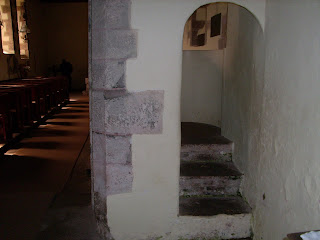







Today I began the serialisation of the podcast of the Life of the Holy David of Wales written by Rhygfarch a tenth century monk. This was obviously a Life rich in legend with amazing miracles, but must be listened to with great love and faith. Very interesting were the Celtic animal symbols and the gifts which foretold the birth of David. The Bees , the Stag and the Fish and the Serpent, who always caused trouble.
The Stag generally speaking, espeically a white stag symbolised Christ,then bees symbolised Paradise, as Hywel Dda the great King, who wrote Welsh Law and visited Rome to have it ratified writes in the Old Gwentian Law books:the 'Origin of bees is in Paradise, and on account of the sin of man, they came from thence; and God conferred this blessing on them, and Mass cannot be sung without the beeswax.' We also find in the Black Book of St David's that many tenants paid their rents in beeswax!!' The Fish (and especially the salmon-king of fish) was a symbol of Insight and great knowledge, and to eat it would transfer these credits to the person eating it.The story of David mentions Teilo and the symbol of the Pelican seen all over Llandaff, gorgeously gilded. The Pelican is a symbol of the Eucharist. It scratches and tears at its own chest to take flesh and blood for its young, and the analogy with St John 6 is obvious.
Other animals I read about, the snake and dragon symbols of infertility and always causing trouble, negative and unproductive, and yet-some missionaries used the symbol of the snake shedding its coat periodically to explain the resurrection. The Peacock too was a sign of resurrection, because after death, there is a very long time before putrefaction sets in,so perfect is the meat.
Interesting is the Gwentian link with St Non, mother of David. Llan-sant-Non became corrupted into the English Llantarnam, where the magnificent Abbey still remains a Convent for women. Did St Non come here? Well St David did spend a lot of time in his hermitage on retreat,and it was to this remote place (and it is still heavenly there!)that Deiniol from North Wales and Dyfrig of Caerleon came to him to beg him to come with them to Brevi in Ceredigion (Camarthen) and like Germanus before hin refute the teachings of Pelagius.
The site of David's cell at Llanthony is -especially in Spring and Autumn one of the most lovely and spiritual places in Gwent. Close to the Skyrrid, the Holy Mountain, David's cell was surrounded by hills. The small cell was incorporated into the larger church when the Abbey at Llanthony (an Augustinian foundation after the Norman Conquest) was built. The small original cell was reserved then taken over by the Anglican church in the sixteenth century who now administer it. Yes the cell can still be seen as a small part of the larger church. The Stained glass s modern commemorating Dewi's white dowve which landed on his shoulder at Llandewi Brefi.It still lies in the midst of glorious countryside.the area is a haven for ramblers, anglers, horse riders, and if they travel on up the valley they come over to one of the highest spots in Gwent, where they can see the whole county down to the silver streak in the distance which is the Severn. People jump off the highest mountains wearing parachutes and I must say you have the feeling you are on top of the world. The inscription on the window of the local Anglican Chapel is engraved with the beginning of Psalm 121 I will lift mine eyes unto the hills from whence cometh my help!
If you take the road North from Aberganny to Hereford, (the fast road) you turn off at Llanfihangel Crucorney, pass the Skirrid Inn, then turn left, following the signs to Llanthony Abbey. To see it at its best, go in Autumn or Spring. It is magical.
Hope all you Welsh in Patagonia had a Happy and Blessed St David's Day!





















































































No comments:
Post a Comment